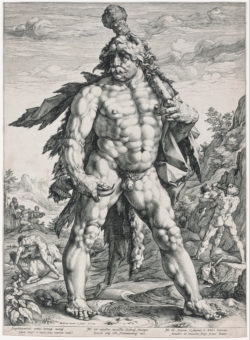Woodall Abstract Monstrous Masculinity?
Joanna Woodall
Monstrous masculinity? Hendrick Goltzius' 1589 engraving of The Great Hercules

Hendrik Goltzius 'The Great Hercules' (1589); Engraving, w. 40.5 x h. 56.1 cm; Cincinnati Art Museum
The Great Hercules was published by Hendrick Goltzius in the city of Haarlem at a decisive moment in the revolt of the Netherlands against their Habsburg sovereign, Philip II of Spain. The huge engraving appeared on the eve of the renowned printmaker’s departure for Italy, where he would encounter and study the antique statues to which his print alludes. According to his friend, Karel van Mander, Goltzius took copies of the engraving with him on his journey and discussed it with a fellow artist. This chapter describes the kinds of knowledge available to the work’s initial viewers. They may, for example, have read Hercules Prodicius, an allegorical travelogue and mirror for princes published in Antwerp by the antiquarian Stephanus Vinandus Pighius in 1587. Noting how art historians have tried to contain and stabilize the wayward figure by recourse to traditional methodologies such as iconology and the construction of an Author, the chapter points out the mobile and expansive aspects of The Great Hercules. This ‘monstrous’ overdetermination is related to the phenomenon of aporia, in which internal contradictions generate a state of confusion comparable to Hercules at the Crossroads. Aporia, according to Aristotle, was the initial impulse to philosophical thought. The chapter suggests that the marvelousness, and monstrosity, of The Great Hercules lie in its aporetic capacity to mobilise its viewers to wonder and think about masculine virtue by offering multiple, contradictory paths, and challenging them to find a way among them. In doing so, the image can be seen to force or facilitate a re-charting of the masculine subject for the ‘new world’ that was incipient in 1589.
The Exemplary Hercules - chapter 7
